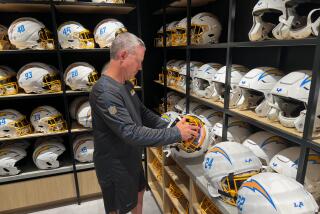Small Ohio Town Has Big Say in How Super Bowl Ball Bounces
- Share via
CLEVELAND — The footballs used in Super Bowl XIX will be passed, punted, spiked, snapped, intercepted and maybe even fumbled, but only once will they be turned inside out--at the Ohio factory that makes them.
The Wilson Sporting Goods factory in Ada, about 60 miles south of Toledo in western Ohio, has been the NFL’s sole supplier of footballs for 30 years.
“We’re pretty proud of our people here,” Ada plant manager Tom Elkins said in a telephone interview. “They’re good solid Ohioans. Most are Cleveland fans.”
But the Browns didn’t make the playoffs, and the Wilson employees’ handiwork will be used Jan. 20 in Stanford, Calif., by the Miami Dolphins and the San Francisco 49ers.
The making of the football begins with four oblong panels of tough leather--”basic” cowhide, not the pigskin of legend--each lined and sewn together inside out.
The sewing, done on huge, noisy machines, is actually the most important part, despite the quirky visual appeal of “turning the football,” Elkins said. “Those oblong panels, you just can’t stick them together any old way. The shape of the ball controls the flight, the spin.”
Then comes what he called “the most physical” part of manufacturing the ball. One of 10 employees trained specifically for the unusual process takes the inside-out ball, points the ends together inside the ball, and pulls them out through the opening left for the lacing.
“There is a knack for doing it,” Elkins said. “It takes quite a bit of strength. Some people can do it, some can’t. I don’t turn the football, no ma’am.”
“I’ve seen a lot of players try, and a lot of them fail,” Wilson employee Harry Moore said . “I turn one every 40 seconds, but I’ve seen many NFL players and football coaches try, and none of them could do it in five minutes.”
Once the ball is turned, the valve-type bladder is inserted, and the ball is laced twice and inflated for testing and examination. Then it is slightly deflated to take the strain off the seams and kept in unsealed plastic bags to prevent condensation.
The balls will be given the same special attention all Wilson footballs receive, Elkins said--careful inspection and up to 20 quality control tests to ensure they meet the strict standards set by both Wilson and the NFL.
More to Read
Go beyond the scoreboard
Get the latest on L.A.'s teams in the daily Sports Report newsletter.
You may occasionally receive promotional content from the Los Angeles Times.










